Have you ever wished you’d been an early adopter of a now-competitive marketing channel like SEO or pay-per-click advertising? The chance you’ve been waiting for could be hidden in plain sight — in fact, you may already have it on your smartphone.
As a relatively recent channel with a massive user base, WhatsApp presents a major opportunity for brands to generate leads and connect with consumers. How can you maximize lead generation through this conversational channel and build more (and deeper) customer relationships?
Read on for your complete guide to WhatsApp lead generation, including the benefits of WhatsApp as a marketing channel and best practices for making the most of your efforts.
You’ll learn:
— A WhatsApp crash course
— Why use WhatsApp for lead generation
— Lead generation fundamentals
— Building customer relationships the right way
— 5 ways to send people to WhatsApp
— Do’s and don’ts of WhatsApp lead generation
— What’s possible with WhatsApp
A WhatsApp crash course
With 2 billion users and the title of the most popular messaging app worldwide, WhatsApp likely has a place on your smartphone’s home screen.
You’ve likely used it to keep up with family and friends. You probably also know that it’s a great way to connect with your customers and respond to their product questions, support requests, and order status checks.
Nine years after WhatsApp’s founding, the app released WhatsApp Business in 2018, offering businesses a whole new way to interact with audiences. Businesses can use the WhatsApp Business app — with less functionality for smaller teams — or use the API for deeper use, like automation and collaboration features.

👉Want a deeper dive into the WhatsApp Business API? We’ve got you covered with this guide.
Until 2022, using WhatsApp as a marketing channel was nearly impossible. WhatsApp had a strict commerce policy that prevented brands from sending non-service-related interactions.
Even now, the only possibility of outbound customer messaging is using a pre-approved WhatsApp template, unless you’re replying to a customer’s message within 24 hours.
But with the introduction of broadcast messaging for businesses, the WhatsApp marketing game has drastically shifted.
Rather than just providing shipping updates or support, WhatsApp is now a great space for businesses to offer value to customers and build relationships.
It’s an ideal time to add this highly popular app to your marketing toolbelt and start generating leads directly through WhatsApp because many brands aren’t using WhatsApp in this way.
Why use WhatsApp for lead generation
You might be thinking, “WhatsApp is fine for personal conversations, but I’m not yet sure if it's right for connecting with my customers.” Let's see what the numbers have to show us.
More than 175 million customers contact businesses using WhatsApp daily. In addition, over 5 million businesses use WhatsApp Business, so those brands that adopt the channel are in good company.
WhatsApp offers an important way to keep up with your competition and give your customers the chance to contact you using one of their favorite channels.
WhatsApp helps brands stay competitive in other ways, too:
- WhatsApp Business speeds up customer service by 225%
- WhatsApp Business increases sales by 27%
- WhatsApp Business improves conversion rates by 20%
With WhatsApp garnering better sales and more conversions, it’s no wonder the channel is ideal for generating leads. Here are a few more benefits of WhatsApp lead generation.
Massive open rates
.avif)
As of 2022, the average email open rate across all industries is 21.5%.
The average open rate for WhatsApp Business API messages? 98%. WhatsApp is a trusted, dependable channel for customers — moreso than email — and its open rate alone is a compelling reason to use it for lead generation and nurturing.
What’s more, WhatsApp Business boasts a response rate of just less than 50% from customers. If you’re looking for a new lead generation channel that will be worth the time and money you invest into it, WhatsApp is the right answer.
Drive sales and build relationships
Your customers expect near-instant responses to their pressing questions. Young consumers, in particular, aren’t willing to fill out forms or send emails to brands with unclear or unreliable response times. If they don’t find immediate answers, they’re likely to move on to another brand that makes learning about its products or offerings easy.
On the other hand, when you provide simple support options like WhatsApp (which your customers already love using), they’re much more likely to reach out to you. When they do reach out — and you provide helpful responses right away — it’s time to start building and nurturing relationships with them that keep them around for the long haul.
Get ahead of your competition
Direct channels like email still hold value, but according to research from Gated, 67% of people report feeling overwhelmed by their inboxes. Consumers receive an abundance of marketing emails every day, so standing out when your audience is drowning in unread messages poses a major challenge for brands.
While inboxes are heavily saturated — with everything from competitors’ messaging to outright spam — WhatsApp is still a new channel. With just five years under its belt, WhatsApp Business offers the chance to stand out early and make an impression on your audience. Your lead generation efforts through WhatsApp are much more likely to take hold while most other companies aren’t taking advantage of this channel.
Now that we’ve covered the virtues of lead generation through WhatsApp, let’s dive into some of the principles of powerful lead generation.
Lead generation fundamentals
For metrics-driven sales and marketing teams, it can be all too easy to get caught in a trap of thinking about leads as mere numbers — rather than real people.
In the rush to sell more, marketers often zero in on ambitious metrics set by their executive teams. They try to inflate their lead numbers at any cost, whether or not the leads are actually interested, qualified, or even real — and most pass on those leads to sales no matter what. As research from Verse found, 44% of sales teams cite low-quality leads as their top complaint in the lead handoff process from marketing to sales.
Yet even the longest list of shallow, irrelevant leads is useless to your brand from every angle. You may think you’ve accomplished something in the short run, but if they don’t trust or like your brand, they won’t buy from you and they certainly won’t feel loyal to you.
Marketing to humans
When your potential customers can tell that you don’t care about their needs or aren’t paying attention to their intent, they won’t trust you. And in a crowded marketplace, trust is essential.
To build trust, start by considering the customer’s journey. Don’t use the same WhatsApp messaging and outreach strategy for everyone. Instead, consider where, how, and why someone gave you their contact details. Then, use that information to continue the conversation thoughtfully, in ways that helpfully move them closer to a purchase — but don’t force it.
As you meet their needs by providing value, those leads can become customers. But this won’t happen if you lose their trust by spamming those who give you their information.
Minding the customer journey
What might these principles look like in practice?
Let’s say you provide haircut services to your customers. There should be a clear difference between how you respond to a lead who gives you their contact information when they book a haircut and someone who signs up for your newsletter or email list.
The person who booked an appointment expressed a clear intent and need for your service. You might follow up with them to nurture the relationship by sending reminders on WhatsApp to book another appointment in the future, particularly if you also asked them for their preferred haircut cadence. A message that acknowledges it’s been four months since their last appointment, for instance, shows you’re paying attention to them and goes further than just offering them a discount.
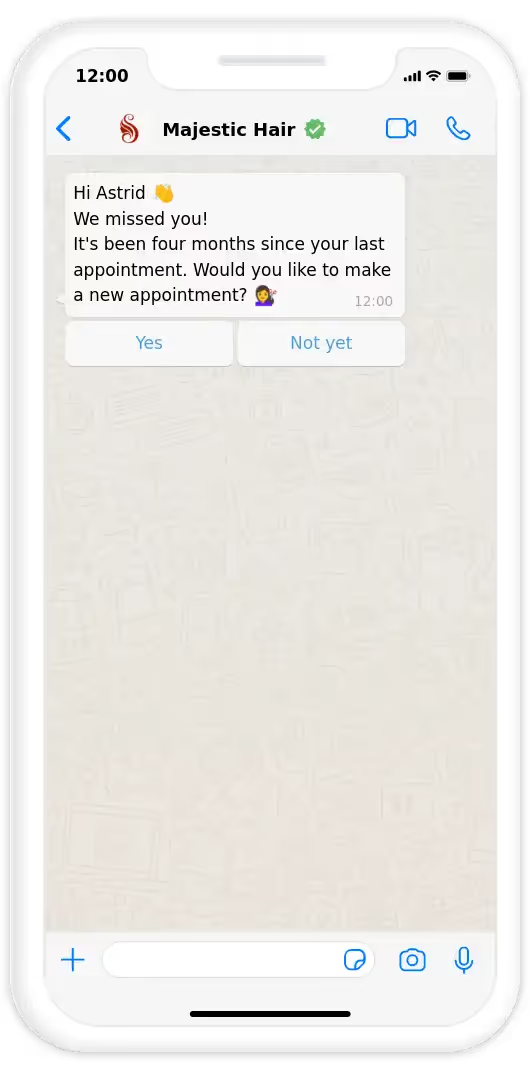
Building customer relationships the right way
The highly relational nature of WhatsApp — and customers’ familiarity with using the channel for casual catch-ups — presents both an opportunity and a challenge for brands. Those that do well on WhatsApp will take a personal, intentional approach to interacting with customers.
When your priority is to build meaningful customer relationships on their terms, you’ll find greater success in encouraging customers to reach out via WhatsApp. You’ll also draw more customer replies and more meaningful responses.
This is why personalization is so important. Personalization is a marketing buzzword and for good reason. According to McKinsey, 71% of consumers expect companies to deliver personalized interactions. Customers want brands to cater to their needs — brands that don’t will quickly fall behind.

Leading with value
The best practices of building customer relationships aren’t unique to WhatsApp — you should lead with value on every channel, from social to email to SMS.
As you market and generate leads through WhatsApp, focus on offering meaningful content that your audience will love. At all costs, avoid abusing their trust and the contact information they provide in exchange for value and support.
Focus on playing the long game of nurturing WhatsApp leads over time with tactics like value-driven WhatsApp newsletters.
Use WhatsApp newsletters to send channel-exclusive content that your customers won’t find anywhere else — from discounts to product samples to insights to help them use your product. Promote these benefits to encourage people to reach out via WhatsApp because they won’t get these perks elsewhere.
You can also use WhatsApp Business notifications to thoughtfully nurture your audience. Share automated information like appointment reminders or shipping updates. Or send personalized messages reminding an existing customer how long it’s been since their last order (and encouraging them that it might be time to order again).
Plenty of brands have used WhatsApp to think well outside the box with creative marketing campaigns designed to offer audience value.
Looking ahead, the possibilities for informing, helping, and even entertaining through WhatsApp are endless.
5 ways to send people to WhatsApp
Now that you’re (hopefully) buzzing with ideas for how to engage your audience and generate interest in your brand, let’s get tactical. How will you let your audience know they can connect with you through WhatsApp so they’re excited to start a conversation with you?
Try these five tactics to encourage your audience to use WhatsApp.
1. Use a WhatsApp chat on your website
Many brands use a live chat on their website as the default way for customers to reach out, but this approach has drawbacks for brands and customers. Shoppers have to wait around on your website for a reply, and your team can’t reach out again after they’ve left.
Using a WhatsApp chat on your website instead helps to solve both of these problems. WhatsApp allows you to keep the conversation going without the inconveniences of traditional live chat. Offering a WhatsApp chat on your website lets you provide personalized service and collect leads by sending people to a channel they love.
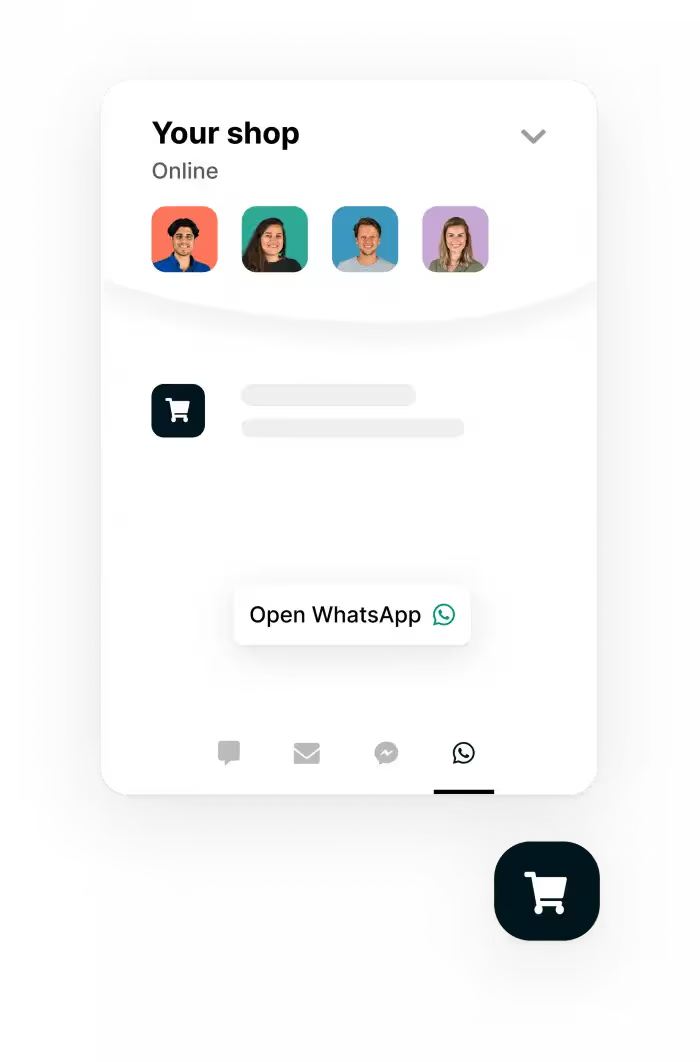
👉Ready to set up WhatsApp chat on your website? We guide you through the process step by step.
2. Create a WhatsApp QR code
Now that so much of our lives are spent online, it’s easy to think that digital channels are the only way to engage customers. But when most brands focus on their online efforts, print media is still a great way to stand out — as long as you feature a clear call to action.

Including a WhatsApp QR code on your printed marketing materials — from a thoughtful flyer to a clever postcard — accomplishes this. The QR code gives customers a straightforward next step they can take to connect with your brand. Encourage people to reach out by asking them a question or inviting them to enter a contest.
Best of all? You can make a WhatsApp QR code in less than two minutes.
3. Try out click-to-WhatsApp ads
Have you tried advertising with the “Send Message” button?
With click-to-WhatsApp ads, you can directly connect your lead to a customer service agent on WhatsApp. This offers potential customers a clear call to action when an ad catches their eye. Rather than having to search to figure out how to contact you, customers can start a conversation with you in seconds.
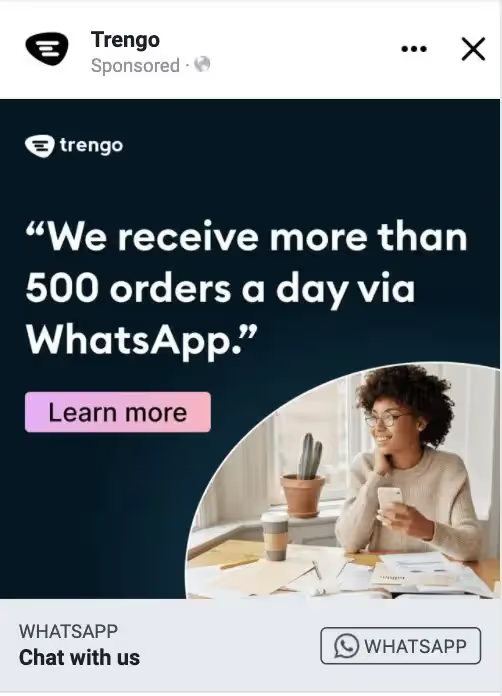
Make sure that as soon as they reach out, your lead feels invited into a true conversation. Your agents should ask them direct questions designed to get to know them and show expertise to help customers get what they need.
Think of this interaction in the same way you would if someone walked up to a sales agent in a brick-and-mortar store. Be friendly and engaging, but focus on helping them find what they need in a timely manner. Take advantage of the highly interpersonal nature of WhatsApp, and show off your added value.
4. Use WhatsApp in your email signature
Another great way to send your customers to WhatsApp is by letting them know it’s available when you’re connecting with them through other channels like email. Try putting a click-to-WhatsApp link in your email signature.
If you’re already including your phone number, replace it with a link to invite people to talk to you directly on WhatsApp. As soon as they click through, they’ll be launched straight into a conversation with you on the app.
5. Set up a WhatsApp chatbot
Chances are good that you don’t offer 24/7 customer support. (Even if you do, your team members likely have too much on their plates to truly work around the clock.)
But for your customers, the shopping never stops. They might have questions about your products and brand at any time of day or night, and if they don’t get a response right away, you’re likely to lose those leads. With a WhatsApp chatbot, though, you can make sure your customers have a touchpoint with your brand whenever they need one.
A WhatsApp chatbot collects leads via WhatsApp when you aren’t available. A chatbot can recognize keywords to understand customer questions and craft a relevant reply.
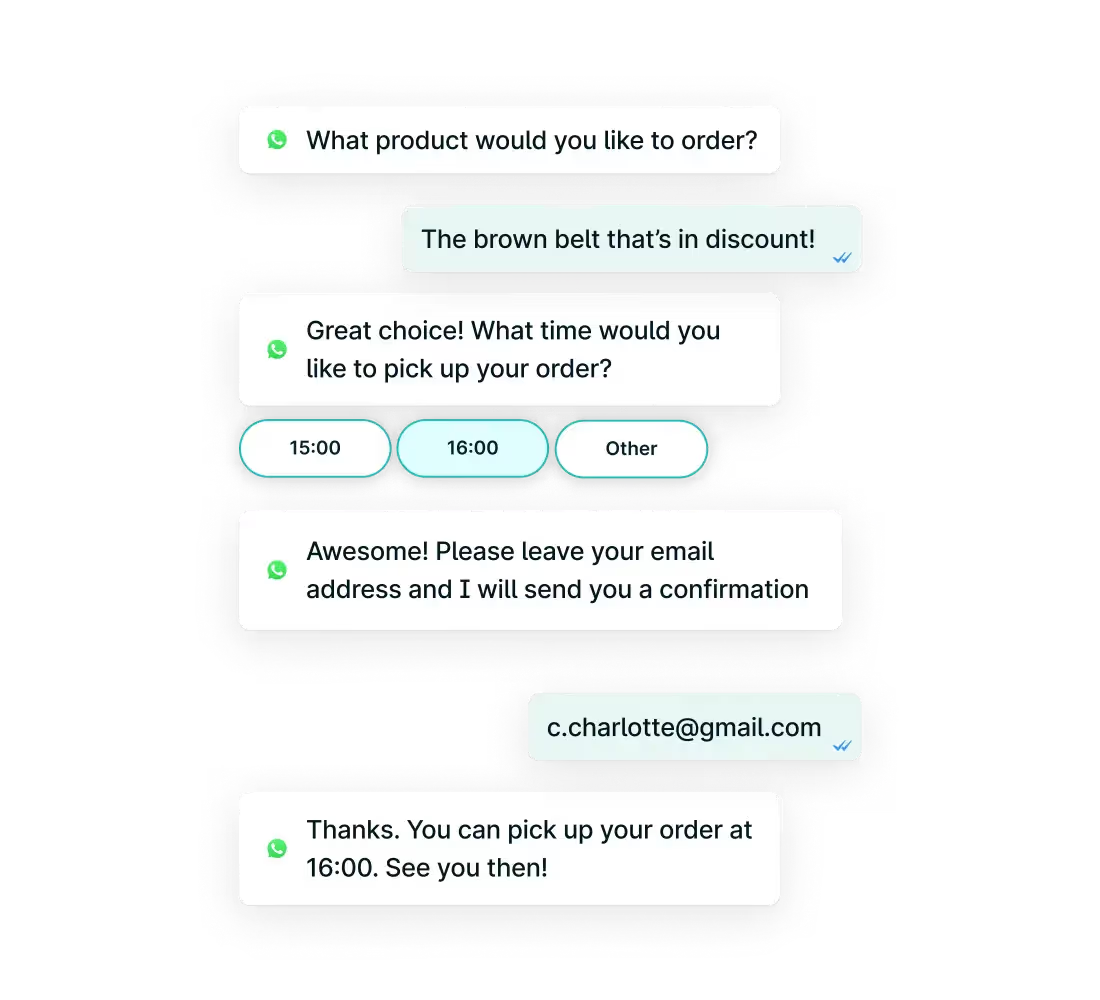
The more you teach the chatbot, the better it will be at simulating an employee and helping customers. Offering a WhatsApp chatbot ensures leads always get an answer, along with collecting personal information and setting up appointments.
Do’s and don’ts of WhatsApp lead generation
Since WhatsApp is the latest and greatest in customer communication (and lead generation), you might be wondering how you can best make use of it to connect with your customers.
Review this list of do’s and don’ts to put your best foot forward with customers on WhatsApp and generate leads that become lasting customer relationships.
Do adapt to WhatsApp — don’t talk like you do on other channels
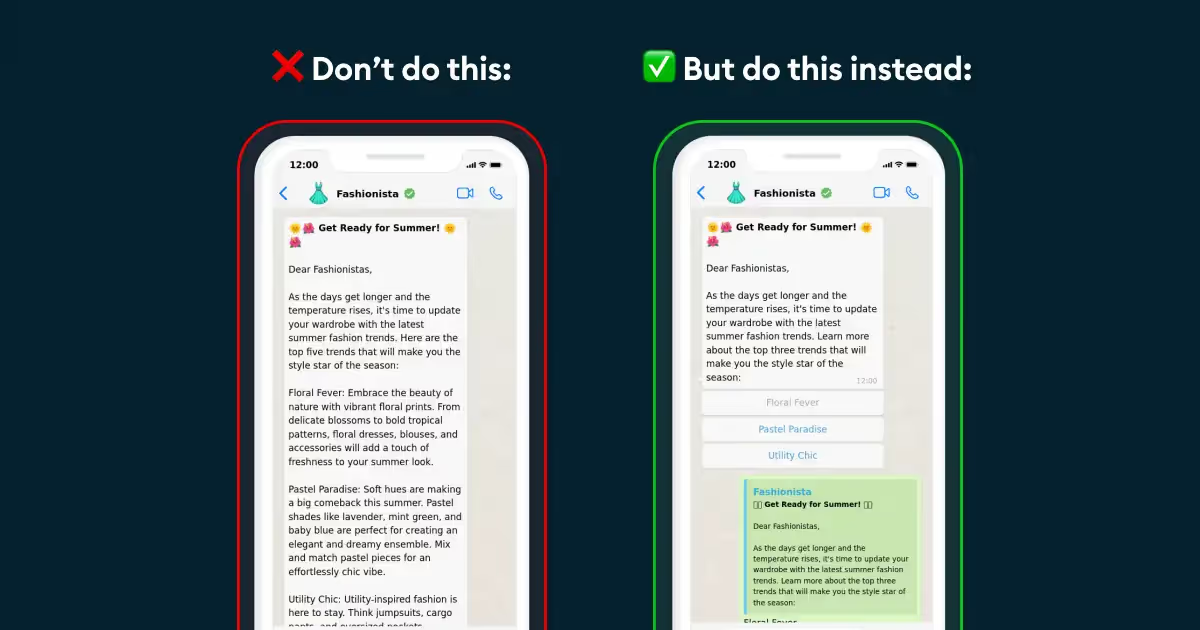
While the principles of lead generation are the same from channel to channel, your messaging and tone shouldn’t be. People use WhatsApp like any other texting app and most often to text their friends and family. They send messages that sound like how they talk — and messages from your brand should reflect those expectations.
You might be used to sending long-winded emails with several sentences in a paragraph or long-winded descriptions. But for WhatsApp, this approach is the wrong call. Your audience doesn’t want to read a wall of text on WhatsApp. They want you to make your point fast.
Send WhatsApp messages that are short and sweet — ideally no more than a sentence or two — that feel like conversational texts. Get to a clear action and value right away.
Do show your brand’s personality
Did you know that nearly 9 out of 10 consumers say that authenticity is important to them when choosing which brands to support?
.avif)
People want brands to be honest and upfront about their values and who they are. Because WhatsApp is such an interpersonal channel, authenticity is all the more important when connecting with customers.
In every message, reflect your unique brand voice and personality. If your brand is the kind to use emojis and exclamation points, WhatsApp is the perfect channel to do so. Your marketing should feel like a conversation with customers, so don’t be afraid to get creative, funny, or entertaining.
Don’t go straight for the sell
We get it — when an interested customer reaches out through WhatsApp, it can be so tempting to figure out just how quickly you can get them to buy.
But if you switch right to converting or closing messaging as soon as someone engages with you on WhatsApp — without paying attention to their intent — you’ll frustrate them at best and, at worst, turn them away completely.
Consider where they are on their journey today and ask whether they’re still learning more or need resources or expertise to guide their search. Build your outreach around their needs and priorities before going to a hard sell, “buy now” approach
Don’t neglect current customers — do keep nurturing after the purchase
Your WhatsApp marketing job isn’t done after a customer buys for the first time. In fact, that’s an ideal time to show customers that you care about your relationship with them and that their business matters. This is where the long-term nurturing starts — and from a business standpoint, this is the time when your approach can make or break the lifetime value (LTV) of your customers.
After a customer has placed an order, offer value-focused resources designed to help them understand and better use your product.
Provide personalized guidance based on their prior purchases, including complementary products — but be sure to time this right. Don’t bombard them with more marketing right away. Let some time pass for their order to arrive and for them to surface any concerns with the product. That way, you’ll ensure they’re happy with the product and receptive to the idea of buying from you again.
Do set follow-up expectations
While one of the benefits of using WhatsApp is that customers don’t have to wait around on your website for a response, they won’t wait forever. That’s why you need to set follow-up expectations, particularly in busy seasons or if a prospect reaches out when your office is closed.
When a lead reaches out, make sure they know as soon as possible when they’ll receive a response. Whether you use an auto-reply or a chatbot designed to note certain keywords to answer straightforward questions, take the time to reassure your leads that a response from your team is on the way. You can also ask them to leave their contact information and get back to them the next day.
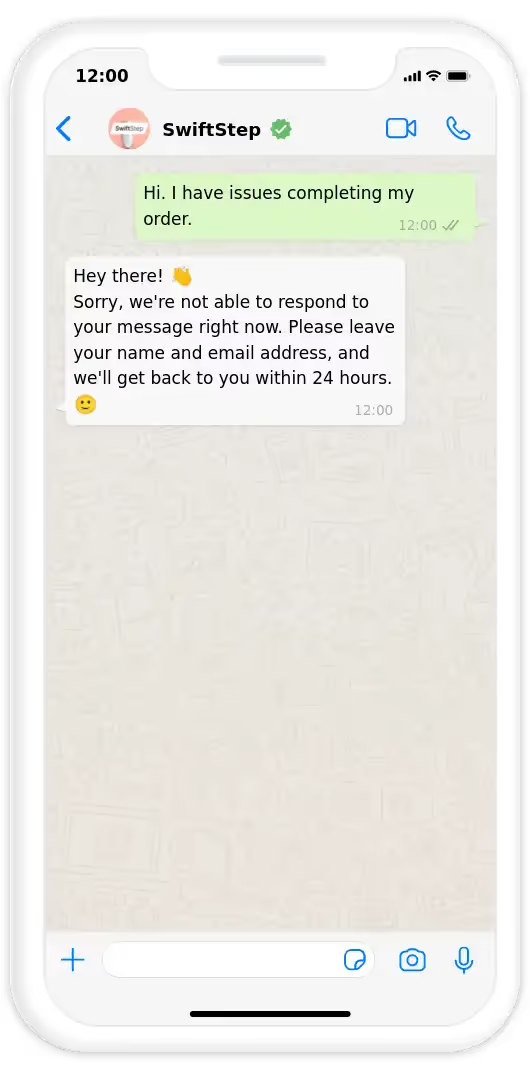
Do spend time on informal conversations — don’t neglect automation
On WhatsApp, a little bit of the human touch goes a long way. But unfortunately, the time it takes to add the human touch also adds up quickly. Although it’s worthwhile for your team to invest time in crafting thoughtful WhatsApp messages, they only have so many hours in a day.
You might not always have the time to personalize responses or go above and beyond.
Automations can help. Tools like quick replies and chatbots can help you simplify the repetitive tasks that can pile up, saving your customer service and sales teams valuable time to reinvest in customer conversations.
The goal here is to save time when and where you can, then reallocate the time you save to build relationships and make customers feel heard.
What’s possible with WhatsApp
The time to start using WhatsApp as a powerful marketing tool is now — if you do, your marketing potential is unlimited.
Take a look at how some brands use WhatsApp to deepen audience relationships and grow their businesses.
BAS World: Speaking customers’ language (literally)
Headquartered in Veghel, The Netherlands, BAS World is the largest truck and trailer dealer in Europe. As such, their customer service team typically juggles 30 to 40 messages from buyers or sellers daily. These messages come to their Trengo inbox via WhatsApp and live chat, and the team aims to answer all inquiries as efficiently as possible.
But because they serve customers across Europe, their audience spans many languages — which could pose a massive challenge for the team. They worked with Trengo to offer flowbots in 13 languages so customers could connect with BAS World resources in their preferred language. The flowbot offers the added benefit of responding to messages outside of business hours so that the team doesn’t lose those leads.
Leads can choose to message with the flowbot throughout their conversation or switch to a sales employee.
BAS World gives customers multiple options for contacting them — including WhatsApp — and a way to connect in their language of choice. These solutions help BAS World generate more leads — including 57 orders via the flowbot in one month. But just as importantly, they set BAS World apart as a brand that prioritizes its customers’ experiences.
What will you achieve with WhatsApp?
Now you know the ins and outs of WhatsApp lead generation. (Congrats!)
Ready to put the world’s top messaging app to work for your brand? WhatsApp is the channel to build and nurture customer relationships — and with the help of the WhatsApp Business API, your team can collaborate and automate like never before. Watch your leads roll in, then get ready to blow them away with top-notch service.
Trengo is here to help you tap into the API and all the functionalities you need to offer a modern customer experience on WhatsApp.
Let's meet up
Frequently asked questions
What is WhatsApp lead generation and why should marketers care?
WhatsApp lead generation is the process of attracting, engaging, and converting potential customers through WhatsApp’s messaging platform. Marketers should care because WhatsApp offers exceptionally high open rates—around 98%—and direct, personalised interaction that builds trust and accelerates conversions. Trengo leverages WhatsApp Business API to help marketers capture and nurture leads efficiently.
What kinds of leads can I capture through WhatsApp?
You can capture warm leads actively engaging with your messages, cold leads through click-to-chat ads, and repeat leads via broadcast or drip campaigns. WhatsApp supports sending multimedia, enabling businesses to share product catalogues, demos, or offers that encourage prospects to respond and convert. Trengo’s unified inbox and automation make managing these diverse leads scalable.
How do I build a WhatsApp lead generation funnel step-by-step?
Start by driving traffic using ads or organic posts with click-to-WhatsApp links. Engage visitors instantly with automated greetings and qualifying questions. Provide timely information or offers to nurture leads down the funnel. Use Trengo to automate conversational flows, capture data, assign leads to sales agents, and monitor funnel effectiveness via analytics.
Which tools or platforms help run WhatsApp lead generation campaigns effectively?
Apart from WhatsApp Business App and API, platforms like Trengo provide integrated solutions including chat automation, shared inboxes, CRM integration, and campaign analytics. These tools reduce response time, improve personalisation, and streamline lead management across teams and channels.
How can automation and chatbots help with lead capture and qualification on WhatsApp?
Automation bots instantly qualify leads by asking relevant questions and routing qualified prospects to sales reps. They also manage scheduling, reminders, and follow-ups. Trengo’s AI tools and customizable chatbots optimise lead capture processes, allowing businesses to engage prospects 24/7 without manual effort.
How do I scale WhatsApp lead generation when volume increases?
Scaling requires robust automation, multi-agent support, and integration with CRM for lead tracking. Trengo’s platform supports unlimited agents managing the same inbox, automated routing, and AI-driven prioritisation, enabling seamless scaling without losing quality or speed.
What budget and resources do I need for WhatsApp lead generation?
Costs depend on message volume, required automation, and integrations. Trengo offers scalable pricing compatible with small to large businesses, combining WhatsApp API access, automation features, and team collaboration tools in one affordable package. Investing in staff training to manage conversations is also essential.
Can Trengo automate WhatsApp lead capture, assign leads, and alert the right sales agent?
Yes, Trengo’s automation workflows can capture lead information from WhatsApp messages, assign leads based on rules like geography or product interest, and alert designated sales agents instantly. This reduces response times, increases lead conversion, and ensures every prospect gets prompt attention.




.png)











